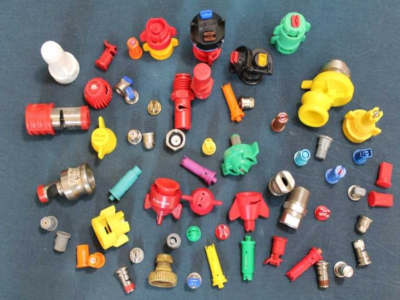By Erdal Ozkan
This is the time of the year you must complete shopping for nozzles because the spraying season is just around the corner. Each part of the application equipment plays a critical role in achieving maximum performance from the sprayer. Therefore, each component must be selected carefully and must perform successfully the tasks associated with it. Although nozzles are some of the least expensive components of a sprayer, they hold a high value in their ability to influence sprayer performance. They help determine the gallon per acre intended application rate. They also influence the droplet size, which plays a significant role in achieving improved penetration into crop canopy and better coverage on the target pest, both affect the efficacy we expect from pesticides applied. Wrong choice of nozzle may hurt us in several ways, but here are the three most obvious ones: We may end up with streaks of untreated areas causing non-uniform pest control; or simply complete failure or ineffective pest control which require repeat applications; and finally, we may end up losing a significant part of the pesticides applied in the form of spray drift. Sometimes, the choice of nozzle may be determined by the requirements given on the pesticide label.
Selecting the best nozzle requires careful consideration of many important factors including: sprayer operation parameters (such as application rate, spray pressure, travel speed); type of chemical sprayed (herbicides, insecticides, fungicides); mode of action of chemicals (systemic, contact); application type (broadcast, band, directed, air assisted); target crop (field crops, vegetables, vineyard, shrubs and trees, etc.); and spray drift risk. I will briefly cover some of these topics in this article. For detailed information on nozzle selection, I strongly recommend you read a new Ohio State University Extension Publication, entitled “Selecting the Best Nozzle for the Job”. In this publication, you will see step-by-step guidelines for selecting the most appropriate spray nozzle for a given application situation. The publication is available online at following web site: http://ohioline.osu.edu/factsheet/fabe-528
Which nozzle type is best for your situation?

When I get a question like, “what is the best nozzle I can buy?”, my answer is: it depends on the job on hand. The nozzle selection is a two-step process. First, we need to determine the type of nozzle best for a given situation. Next, we need to determine the appropriate size of that nozzle that will be capable of providing the desired gallons per acre application rate under various operating conditions such as travel speed and spray pressure. Each nozzle type is designed for a specific type of target and application. For example, a nozzle designed for broadcast spraying is not good for spraying pesticides over a narrow band. While one nozzle may be best for a given situation, it may be worst choice for another. For example, we at Ohio State University have conducted field experiments to determine which nozzles to choose for two different application situations: soybean diseases such as rust and white mold, and wheat diseases such as head scab and stem rust. We included 6-8 different nozzles in the experiments. We found out that while a twin-fan pattern nozzle was best for controlling wheat head scab, the same nozzle turned out to be the worst choice to protect soybeans against rust and white mold when the soybean canopy is tall and dense. So, before buying the nozzles and putting them on the boom, check the nozzle manufacturers’ catalogs which have charts showing which nozzle type will be best for a specific job. Check the websites of nozzle manufacturers to reach their catalogs.
Nozzle size
Once you determine the type of a nozzle you need to buy, you also must buy the right size of that nozzle which will satisfy the application rate (gallons per acre or gpa) you wish to use as you do your spraying at different travel speeds. Nozzle catalogs are filled with tables and charts showing application rates, given a nozzle’s flow rate (gallons per minute or gpm) delivered at various pressures (psi) and travel speeds (mph). However, the charts are only for a limited number of travel speed and nozzle spacing situations. Most nozzle manufacturers have developed Apps for smart phones that provide you the exact nozzle flow rate required for any given set of application parameters, and identify a specific set of nozzle recommendations for the given application parameters. To find these Apps, simply visit the App Store in your smart phone or tablet and do a search under “Spray Nozzle Calculator”, or some other key words related to nozzle size selection.
Keep several types of nozzles on the boom
Remember that one specific type of nozzle will not be best for all applications. For this reason, it is best to have several types and sizes of nozzles on the boom so that you can switch to the “best” nozzle choice for a given spraying job. As shown in the pictures below, there are various types of sprayer components and setups you can buy to configure your boom so the new set up allows you to easily switch from one nozzle to another instantly.